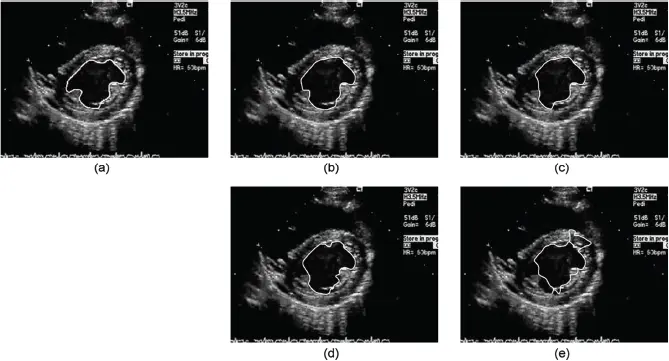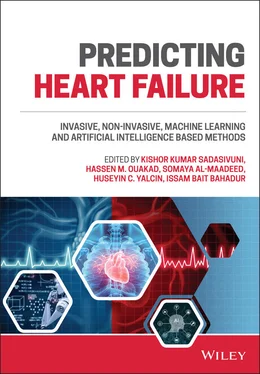Predicting Heart Failure
Здесь есть возможность читать онлайн «Predicting Heart Failure» — ознакомительный отрывок электронной книги совершенно бесплатно, а после прочтения отрывка купить полную версию. В некоторых случаях можно слушать аудио, скачать через торрент в формате fb2 и присутствует краткое содержание. Жанр: unrecognised, на английском языке. Описание произведения, (предисловие) а так же отзывы посетителей доступны на портале библиотеки ЛибКат.
- Название:Predicting Heart Failure
- Автор:
- Жанр:
- Год:неизвестен
- ISBN:нет данных
- Рейтинг книги:3 / 5. Голосов: 1
-
Избранное:Добавить в избранное
- Отзывы:
-
Ваша оценка:
- 60
- 1
- 2
- 3
- 4
- 5
Predicting Heart Failure: краткое содержание, описание и аннотация
Предлагаем к чтению аннотацию, описание, краткое содержание или предисловие (зависит от того, что написал сам автор книги «Predicting Heart Failure»). Если вы не нашли необходимую информацию о книге — напишите в комментариях, мы постараемся отыскать её.
Predicting Heart Failure: Invasive, Non-Invasive, Machine Learning and Artificial Intelligence Based Methods
Predicting Heart Failure
Predicting Heart Failure: Invasive, Non-Invasive, Machine Learning and Artificial Intelligence Based Methods
Predicting Heart Failure — читать онлайн ознакомительный отрывок
Ниже представлен текст книги, разбитый по страницам. Система сохранения места последней прочитанной страницы, позволяет с удобством читать онлайн бесплатно книгу «Predicting Heart Failure», без необходимости каждый раз заново искать на чём Вы остановились. Поставьте закладку, и сможете в любой момент перейти на страницу, на которой закончили чтение.
Интервал:
Закладка:
A decision support system is a software that helps decision making and works based on the ruleset. The rule set can be in the form of simple IF-THEN rules or a more complex structure. Rule sets can be created with the help of expert knowledge or with models that learn from data. Comparing the event that occurred with the rules in the rule set determines which rule triggered the situation. Thus, whichever rule is triggered by the situation to produce the result, the output of the decision support system will be consistent.
Decision support systems are systems that help to decide about a situation. A system that will decide on HF takes the patient’s measurements as input and provides information about the risk of HF as output. The system’s inputs are sometimes the information coming from the IoT devices and sometimes the data that has been entered manually. For example, based on heart rate and blood values, it will be possible to predict whether there will be HF. At this point, we come across systems based on machine learning and knowledge. In machine learning based systems, data classification is carried out with the help of models trained with historical data. As a result of the classification, there might or might not be an indicated risk of HF.
1.5 Diagnosis with Artificial Intelligence Methods
One of the techniques that can be used to diagnose of HF is artificial intelligence and machine learning.
1.5.1 Introduction to Artificial Intelligence
Artificial intelligence is the name of the general discipline that combines software and hardware studies. It includes designing systems that act like a human, learning and making decisions like humans. Scientists have been curious about artificial intelligence since the 1950s and there is increasing interest in it. It has become an even more important discipline with the developments in information technologies. The focus on developing systems that exhibit human-like behavior has already attained this goal in some areas. Examining the recent history of artificial intelligence shows that machine learning algorithms and then deep learning algorithms have led to striking developments. For example, thanks to natural language processing, systems that produce and understand language have been developed; with the help of image processing techniques, systems close to human vision have been developed; systems that imitate human learning, systems that extract information, systems that establish connections have been developed; and studies that reveal abnormal situations have been conducted.
The main reason artificial intelligence-powered solutions have come to the fore is their ability to exploit many advantages of information technologies. Cheaper storage units, the increase in the capacities of the processing units, and advances in artificial intelligence algorithms make the field more popular every day. The cheaper storage units and the increase in their capacity have enabled more patient data to be stored. The increase in capacity and speed in processor units makes it possible to analyze data in a way not possible in the past. In fact, data collection and transfer possibilities from remote units have increased due to the developments in network technologies. All developments favor artificial intelligence and data science, and many jobs have become fulfilled with the help of artificial intelligence and data science.
The developments have also contributed to artificial intelligence programming skills. With artificial intelligence, it has become possible to solve many problems that could not be solved with classical programming skills, and while complex data relationships cannot be solved with classical methods, recently relationships between data have become easily inferred.
One of the areas most supported by artificial intelligence is computer-aided decision making, thanks to its various capabilities, notably diagnosis and prediction. Artificial intelligence-based diagnostic systems can be seen as an example of a non-invasive procedure, because there is no interference with the body in artificial intelligence supported clinical decision support systems, in which expert systems make decisions based on both expert opinions and machine learning systems’ modeling from past case examples. These systems, which are sometimes used separately, are used together in some places. With the increase in the studies on artificial intelligence, its subfields have emerged. There are many artificial intelligence subdomains, each with different characteristics. Among these subareas, machine learning, deep learning, expert systems, and image processing in particular provide auxiliary features in computer-aided decision making.
1.5.1.1 Expert Systems
Expert systems are based on imitating human expertise with machines [17]. They are considered among the first successful applications of artificial intelligence. An expert system is often used in decision support systems development. In addition, the expert system has two components: the knowledge base and the inference engine.
1.5.1.2 Machine Learning
Machine learning is the most prominent area among the artificial intelligence subareas. It is a field focused on developing systems that learn with the help of historical data. As a result of learning, they can classify new data, cluster, establish similarities between data, and capture other relationships. Although supervised and unsupervised learning algorithms are often prominent in machine learning algorithms, semi-supervised and reinforced learning methods are also supported. The main purpose of machine learning algorithms is to aid decision making [18].
1.5.1.3 Deep Learning
Deep learning is a sub-branch of machine learning. It is also recognized as the most powerful alternative to machine learning. It can perform more complex operations with fewer data. In addition, while feature selection is performed manually in traditional machine learning algorithms, this process is automatic in deep learning. The working principle of deep learning algorithms is the working principle of the brain. It is based on densely multilayered neural networks, but constrained Boltzman machines and probabilistic graph models are also associated with deep learning. These are the methods that work with large amounts of data and reach the final output by further improving the results in each layer. It is supervised, unsupervised, or semi-supervised in terms of the type of education. Its prominent algorithms are convolutional neural network (CNN) and recurrent neural network (RNN). Deep learning models have found use in many areas from natural language processing to image processing.
1.5.1.4 Image Processing
Image processing is one of the most important application areas of artificial intelligence. With the help of image processing techniques, visual features are converted into numerical features and thus diagnostic studies are carried out. It refers to studies based on finding the patterns in the images. Especially with the help of 3D image processing, the borders of the diseased areas can be determined (Figure 1.1). Yang et al. [19] conducted a study of the 3D reconstruction of coronary vessels from angiography images, thus providing the possibility of better diagnosis of CAD. In the study, an aperture camera model and optimization methods were used.

Figure 1.1 Images for boundary detection in different views of heart, with permission from Springer Nature [20].
1.5.2 Artificial Intelligence Supported HF Diagnostic Studies
Интервал:
Закладка:
Похожие книги на «Predicting Heart Failure»
Представляем Вашему вниманию похожие книги на «Predicting Heart Failure» списком для выбора. Мы отобрали схожую по названию и смыслу литературу в надежде предоставить читателям больше вариантов отыскать новые, интересные, ещё непрочитанные произведения.
Обсуждение, отзывы о книге «Predicting Heart Failure» и просто собственные мнения читателей. Оставьте ваши комментарии, напишите, что Вы думаете о произведении, его смысле или главных героях. Укажите что конкретно понравилось, а что нет, и почему Вы так считаете.












